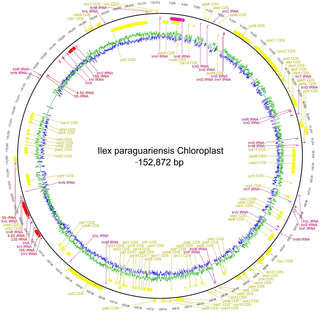Ver ítem
- xmlui.general.dspace_homeCentros e Institutos de InvestigaciónCIAP. Centro de Investigaciones AgropecuariasInstituto de Patología VegetalArtículos científicosxmlui.ArtifactBrowser.ItemViewer.trail
- Inicio
- Centros e Institutos de Investigación
- CIAP. Centro de Investigaciones Agropecuarias
- Instituto de Patología Vegetal
- Artículos científicos
- Ver ítem
Exploring the genes of Yerba Mate (Ilex paraguariensis A. St.-Hil.) by NGS and De Novo Transcriptome Assembly
Resumen
Yerba mate (Ilex paraguariensis A. St.-Hil.) is an important subtropical tree crop cultivated on 326,000 ha in Argentina, Brazil and Paraguay, with a total yield production of more than 1,000,000 t. Yerba mate presents a strong limitation regarding sequence information. The NCBI GenBank lacks an EST database of yerba mate and depicts only 80 DNA sequences, mostly uncharacterized. In this scenario, in order to elucidate the yerba mate gene landscape by
[ver mas...]
Yerba mate (Ilex paraguariensis A. St.-Hil.) is an important subtropical tree crop cultivated on 326,000 ha in Argentina, Brazil and Paraguay, with a total yield production of more than 1,000,000 t. Yerba mate presents a strong limitation regarding sequence information. The NCBI GenBank lacks an EST database of yerba mate and depicts only 80 DNA sequences, mostly uncharacterized. In this scenario, in order to elucidate the yerba mate gene landscape by means of NGS, we explored and discovered a vast collection of I. paraguariensis transcripts. Total RNA from I. paraguariensis was sequenced by Illumina HiSeq-2000 obtaining 72,031,388 pair-end 100 bp sequences. High quality reads were de novo assembled into 44,907 transcripts encompassing 40 million bases with an estimated coverage of 180X. Multiple sequence analysis allowed us to predict that yerba mate contains ∼32,355 genes and 12,551 gene variants or isoforms. We identified and categorized members of more than 100 metabolic pathways. Overall, we have identified ∼1,000 putative transcription factors, genes involved in heat and oxidative stress, pathogen response, as well as disease resistance and hormone response. We have also identified, based in sequence homology searches, novel transcripts related to osmotic, drought, salinity and cold stress, senescence and early flowering. We have also pinpointed several members of the gene silencing pathway, and characterized the silencing effector Argonaute1. We predicted a diverse supply of putative microRNA precursors involved in developmental processes. We present here the first draft of the transcribed genomes of the yerba mate chloroplast and mitochondrion. The putative sequence and predicted structure of the caffeine synthase of yerba mate is presented. Moreover, we provide a collection of over 10,800 SSR accessible to the scientific community interested in yerba mate genetic improvement. This contribution broadly expands the limited knowledge of yerba mate genes, and is presented as the first genomic resource of this important crop.
[Cerrar]

Autor
Debat, Humberto Julio;
Grabiele, Mauro;
Aguilera, Patricia Mabel;
Bubillo, Rosana Elizabeth;
Otegui, Mónica B.;
Ducasse, Daniel Adrian;
Zapata, Pedro Darío;
Marti, Dardo Andrea;
Fuente
PLoS ONE 9 (10) : e109835. (2014)
Fecha
2014-10-16
ISSN
1932-6203
Formato
pdf
Tipo de documento
artículo
Palabras Claves
Derechos de acceso
Abierto
 Excepto donde se diga explicitamente, este item se publica bajo la siguiente descripción: Creative Commons Attribution-NonCommercial-ShareAlike 2.5 Unported (CC BY-NC-SA 2.5)
Excepto donde se diga explicitamente, este item se publica bajo la siguiente descripción: Creative Commons Attribution-NonCommercial-ShareAlike 2.5 Unported (CC BY-NC-SA 2.5)


